Having a sharp knife is important in the kitchen. Even though you have to be wary when using one, a sharp knife is obviously better than a dull knife. When you have a dull knife, you end up tearing food instead of slicing it with precision. Sharp knives also have a longer lifespan, especially when you’re maintaining your best chef knives.
To achieve a sharp knife, you need a high-quality knife sharpener. A knife sharpener can help you retain your knives’ sharp edges of glory. If you’re a beginner, you should learn how to sharpen a knife, but it can be overwhelming to choose a good knife sharpener. There are many different types of knife sharpeners ranging from electric to whetstone. To ease your search, we’ve rounded up the best knife sharpeners that are perfect for any type of blade.
If you’re looking to buy one of these as a gift, make sure you also check out the best kitchen deals for discounts going on right now.
Best Overall: Chef’s Choice 4643 ProntoPro
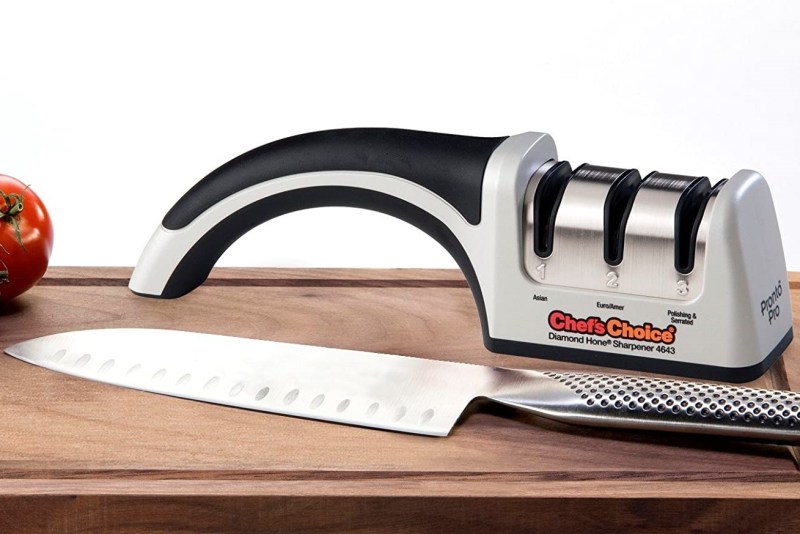
At a reasonable price, the Chef’s Choice 4643 ProntoPro is a knife sharpener that won’t disappoint. This knife sharpener comes with three guide slots for different types of knives. Whether you own an American/European or Asian knife, this sharpener can hone its edge perfectly. With this manual pull-through sharpener, you can control the angle of the knife blade whether it is at 15 or 20 degrees. On top of that, this sharpener has a curved handle for a secure and comfortable grip. It’s also fairly easy to use and durable since it has separate honing stages. This is the versatile manual knife sharpener that is perfect for any kind of knife.
Best Sharpening Set: Edge Pro Apex 4 Knife Sharpening System
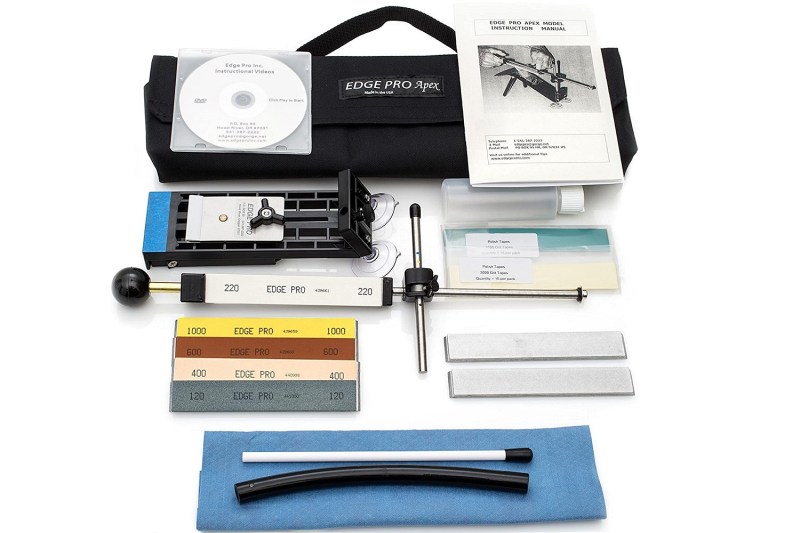
If you’re already familiar with honing knives, a sharpening kit is a worthy investment. The Edge Pro Apex 4 Knife Sharpening System is an excellent knife sharpening kit that works with multiple blade widths. With this set, you can sharpen at various knife blade angles with great precision. You can also polish them further with the included grit stones. This sharpening kit is on the more expensive price point and takes some practice to use well, although you don’t have to worry because this kit comes with a DVD guide that will walk you through using the Edge Pro Apex 4. It will take some time to master this sharpening kit, but the results will leave you beyond satisfied.
Best Coarse Stone: Smith’s TRI-6 Arkansas TRI-HONE Sharpening System

Have complete control over the sharpening process with the Smith’s TRI-6 Arkansas Tri-HONE System. If you want to oversee the honing of your own blade, you’re better off with a manual whetstone sharpener like this one. At a great price point, you get three different grit stones with this sharpening system. For your convenience, the stones are mounted on a triangular block for easier access. It may seem daunting to use a sharpening stone rather than an electric sharpener, but you will be pleased to know that the former is just as easy to use for beginners. Although sharpening knives will take longer, you have precision control when honing with this stone.
Best Compact: KitchenIQ 50009 Edge Grip 2-Stage Knife Sharpener
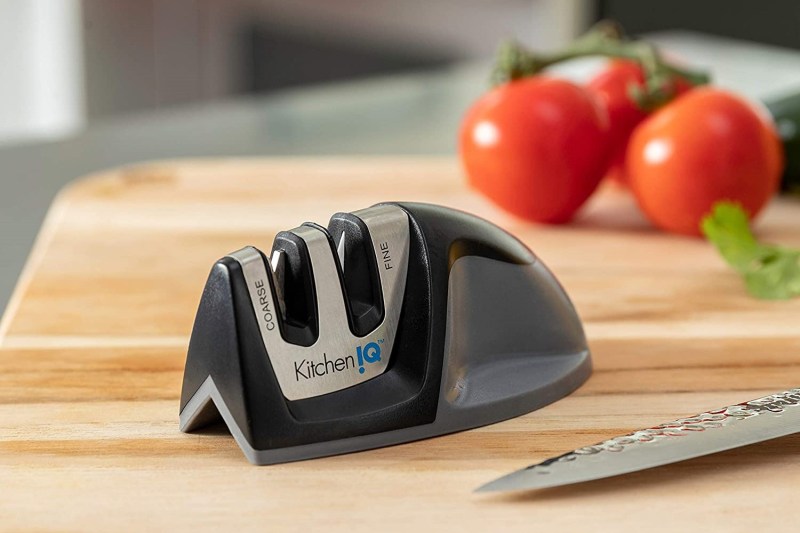
Your knives can achieve a smoother finish with this sharpener. It has two slots; namely, fine and coarse. The coarse slot is perfect for honing dull or damaged knives. On the other side, the fine slot is ideal for touch-ups and polishing an already sharp knife. You get a good-as-new knife with this quick sharpener. The KitchenIQ 50009 Edge Grip 2-Stage Knife Sharpener works for most types of knives, although it’s best suited for straight-edged and double-beveled blades. Another key feature of this sharpener is its compact size, which makes it easy to store inside a drawer or kitchen cabinet when not in use.
Easiest to Use: Presto EverSharp Electric Knife Sharpener

Sharpening knives manually can be a strenuous exercise. With an automatic electric sharpener like the Presto EverSharp, all you have to do is place the knife in the correct position and it will do all the work for you. In less than a minute, you get a good-as-new, sharp, and shiny knife. This electric knife sharpener is incredibly easy to use and offers effective results. You won’t have to worry about the angle or guess which sharpening method will work best. The two-stage sharpening system makes it quicker for you to hone your knives to perfection without the manual work.
Best Versatile: SunrisePro Supreme Knife Sharpener
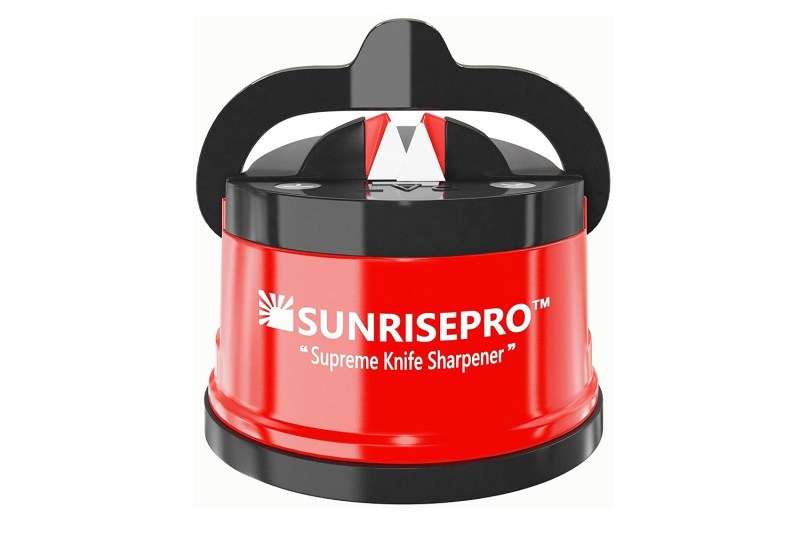
The SunrisePro Sharpener is versatile enough that it can sharpen any type of knife you have in your blade arsenal. Whether you’re using it to sharpen your Asian knife or something as simple as a steak knife, this sharpener works effectively. What’s even better is that you’ll get your money’s worth with this sharpener and it gives your newly sharpened knives a pristine look. It can also fit in smaller spaces in the kitchen since it has a compact size. If you’re looking for a small and cheap sharpener that doesn’t compromise quality, this one is worth a try.
Best Low Maintenance: Lansky 4-Rod Turn Box
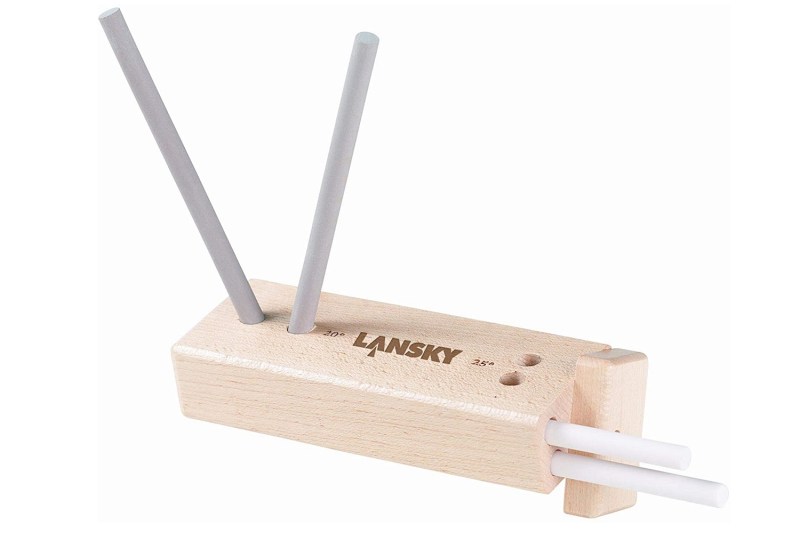
Don’t be fooled by this sharpener’s unfinished and bare look. Although it may not seem like much on the surface, this sharpener is effective in sharpening knives. The Lansky 4-Rod Turn Box has sharpening rods that guarantee a clean swipe when used. This sharpener comes with two sets of medium grit and fine grit 5-inch ceramic rods. Each of these grits is designed to sharpen and hone your knives with the utmost ease and precision. This low-maintenance sharpener is also easy to store in the kitchen. Alongside the easy storage, you can also bring this sharpener on camping trips.
Best Lightweight: DMT CS2 12-Inch Ceramic Steel

Crafted from high-grade materials, this DMT CS2 12-Inch Ceramic Steel is a no-frills sharpener that precisely hones and sharpens your knives. This lightweight and simple-to-use sharpener is perfect to use in the kitchen or bring on camping trips. With this sharpener, you can also hone your hunting and boning knives effectively. Although it takes some practice to get used to this ceramic sharpener, you can achieve professional-grade and optimal results. What’s even better is that this sharpener doesn’t require oil or any liquid — you can simply sharpen your knife dry.
How to Use a Knife Sharpener
With all the different styles of knife sharpener out there, it’s essential to understand how to use them so that you don’t ruin your knives. Here’s a brief overview of how to use the different types of knife sharpeners. However, it’s always best to refer to the product user manual in case your specific knife sharpener has some sort of special design.
Stationary Knife Sharpeners
Stationary knife sharpeners, like most on this list, are fairly straightforward to use. The sharpener remains stationary on the countertop and you pull your knife slowly through from bolster to tip. Stationary sharpeners usually have at least two sharpening settings; coarse and fine. In most cases, blades only need a quick touch-up in the fine slot. But, after extended periods of heavy use without any sharpening, the edge might need to be reformed in the course setting then honed to a fine tip in the fine slot. Some stationary knife sharpeners have sharpening slots for serrated knives. Always refer to the user manual on how to use this setting.
Handheld Knife Sharpeners
With handheld knife sharpeners, the idea is the same as a stationary sharpener but in reverse. The knife should remain stationary as you pull the sharpener over the blade. To do this, hold the knife sharpener in your dominant hand and hold the knife in your other hand on the countertop with the blade facing the ceiling. Carefully run the sharpener over the blade several times until the desired sharpness is achieved.
Whetstones
Whetstones are the best way to maintain the overall integrity of your knife’s edge and the overall life of your blade. However, this type of knife sharpening involves more steps and requires some practice to get right. Like other sharpeners, whetstones have a coarse and fine grain side. Also like other sharpeners, you’ll use the fine-grained side of the stone more often than the course.
Step 1: Soak the stone before sharpening for about 10-15 minutes so water can impregnate the stone.
Step 2: Place a damp towel down on your countertop or table to secure the stone while sharpening. Have another towel handy to wipe down your blade periodically and a cup of water so you can occasionally reapply water to the whetstone for lubricant.
Step 3: Hold the knife handle firmly in your dominant hand. Apply the blade to the stone at about a 20-degree angle. To do this, hold the blade to the stone at a 90-degree angle, halve it, then halve it again. For some thinner Japanese blades, you’ll likely need to try to go even further to a 15-degree angle.
Step 4: Run the length of your blade in a rainbow arch motion, starting with the tip at the base of the whetstone and ending with the bolster at the other end of the stone. Apply some pressure, but don’t press too hard. You’ll need to do this a few dozen times on each side of the blade. Although you can flip the blade in your dominant hand and do the process in reverse for the other edge, you’ll get a better edge if you do the same process in the opposite hand, which requires a bit of ambidexterity. Sharpening the blade in the same direction on both sides results in better honing.
Step 5: Once you think you have your desired edge, hone the blade with a honing steel and then clean the knife.



